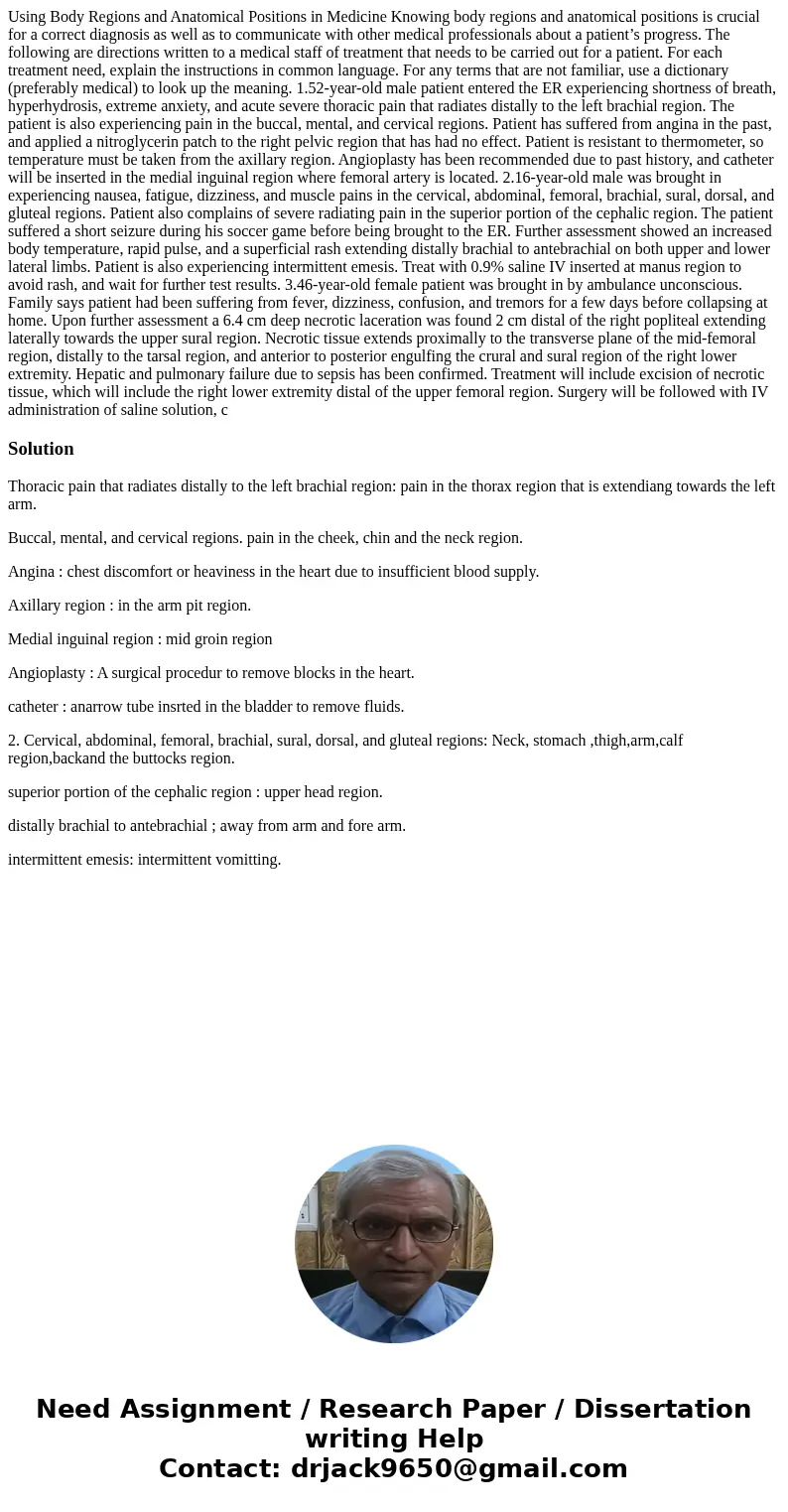Using Body Regions and Anatomical Positions in Medicine Know
Using Body Regions and Anatomical Positions in Medicine Knowing body regions and anatomical positions is crucial for a correct diagnosis as well as to communicate with other medical professionals about a patient’s progress. The following are directions written to a medical staff of treatment that needs to be carried out for a patient. For each treatment need, explain the instructions in common language. For any terms that are not familiar, use a dictionary (preferably medical) to look up the meaning. 1.52-year-old male patient entered the ER experiencing shortness of breath, hyperhydrosis, extreme anxiety, and acute severe thoracic pain that radiates distally to the left brachial region. The patient is also experiencing pain in the buccal, mental, and cervical regions. Patient has suffered from angina in the past, and applied a nitroglycerin patch to the right pelvic region that has had no effect. Patient is resistant to thermometer, so temperature must be taken from the axillary region. Angioplasty has been recommended due to past history, and catheter will be inserted in the medial inguinal region where femoral artery is located. 2.16-year-old male was brought in experiencing nausea, fatigue, dizziness, and muscle pains in the cervical, abdominal, femoral, brachial, sural, dorsal, and gluteal regions. Patient also complains of severe radiating pain in the superior portion of the cephalic region. The patient suffered a short seizure during his soccer game before being brought to the ER. Further assessment showed an increased body temperature, rapid pulse, and a superficial rash extending distally brachial to antebrachial on both upper and lower lateral limbs. Patient is also experiencing intermittent emesis. Treat with 0.9% saline IV inserted at manus region to avoid rash, and wait for further test results. 3.46-year-old female patient was brought in by ambulance unconscious. Family says patient had been suffering from fever, dizziness, confusion, and tremors for a few days before collapsing at home. Upon further assessment a 6.4 cm deep necrotic laceration was found 2 cm distal of the right popliteal extending laterally towards the upper sural region. Necrotic tissue extends proximally to the transverse plane of the mid-femoral region, distally to the tarsal region, and anterior to posterior engulfing the crural and sural region of the right lower extremity. Hepatic and pulmonary failure due to sepsis has been confirmed. Treatment will include excision of necrotic tissue, which will include the right lower extremity distal of the upper femoral region. Surgery will be followed with IV administration of saline solution, c
Solution
Thoracic pain that radiates distally to the left brachial region: pain in the thorax region that is extendiang towards the left arm.
Buccal, mental, and cervical regions. pain in the cheek, chin and the neck region.
Angina : chest discomfort or heaviness in the heart due to insufficient blood supply.
Axillary region : in the arm pit region.
Medial inguinal region : mid groin region
Angioplasty : A surgical procedur to remove blocks in the heart.
catheter : anarrow tube insrted in the bladder to remove fluids.
2. Cervical, abdominal, femoral, brachial, sural, dorsal, and gluteal regions: Neck, stomach ,thigh,arm,calf region,backand the buttocks region.
superior portion of the cephalic region : upper head region.
distally brachial to antebrachial ; away from arm and fore arm.
intermittent emesis: intermittent vomitting.

 Homework Sourse
Homework Sourse